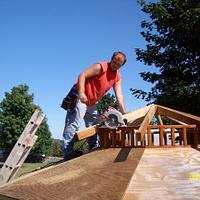monkman
in over 9 years
6 Replies
Monk it may be the motor….chances are it’s not a 220 compatible or your circuit breaker needs a double circuit breaker….similar to your clothes dryer…etc
The horsepower of the motor might be low for the type of wood you’re cutting. Mine slows down when ripping poplar, but does fine with other types of wood. I think slow and steady feeding of the wood, but fast enough to avoid burn marks seems to work.
What do you mean when you say you had the motor “converted to 220”? A motor that is not designed to run on 220V cannot be made to run on 220V. There are motors that are designed to run on either/or depending on how certain connections are made. Is the motor designed to run this way? Also, as rjgray asks, is it plugged into a true 220V outlet?
Changing the plug on a motor designed to run on 110V to adapt it to a 220V outlet can lead to all kinds of bad things happening. Since the motor runs, it may well be designed to run on 220V, but may be wired incorrectly internally.
Some 220V motors will try to run on 110V, but you will permanently damage the motor by overheating the windings.
So,
1) Make sure the motor is designed to run on 220V. The operating voltages should be stamped on the motor plate.
2) Using a multimeter, check the supply voltage at the plug for 220V. There should be 3 prongs. One will be ground. Measuring each of the others to this prong will read 110V . Reading across the other two will show 220V. If it doesn’t, something is wrong.
3) Confirm that the motor is wired correctly for 220V.
What type of saw is it?
Where are the band-aids?---Pro Libertate!
Rich’s reply makes me wonder…did it act like this before the motor conversion?
Where are the band-aids?---Pro Libertate!
It can also be as simple as an out of align table saw.
I helped an associate out in his cabinet shop about twenty years ago. He had a 3 hp Unisaw like mine, but a decade or so older. He complained the quality of the sharpening job he’d just had done on a blade, because it was working hard to get through oak 2x’s.
I brought a set up gauge I’d designed and checked the blade to table alignment. He said he’d just set the saw up using a tape! It was out over 1/16". Once the top was tightened back down, we checked the fence. It was out 1/8" in the same direction (so was also out 1/16"). So we set that too.
Once the saw was aligned, he tossed on the same test oak 2x and was shocked at the difference in the ease of the cut. Essentially, his 1/8" blade had been running more like a 1/4" dado.
My method of set up is:
1) Raise the blade fully;
2) Use an Try-square or something that can adjust and run in the track, push the ruler up against one tooth on the operator side and lock it.
3) Spin the tooth you just set up off of to the back
4) Move your Try-square to the back and note the difference, if any.
5) If there is gap, or the alignment gauge gets tight, loosen the table top from the base and move it that gazillionith of an inch, then re-tighten and re-test, continuing until you’re happy with it.
Kelly thanks for the info.










